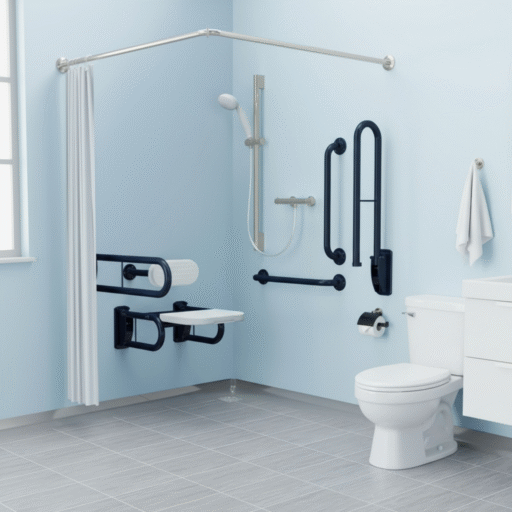How to Create a Safer Bathroom: Wet Room Transformations for Long-Term Comfort in 2025

A wet room transformation directly addresses the primary risks in a traditional bathroom, providing a level, slip-resistant, and fully waterproofed space. This guide explores the core benefits, safety features, and implementation process, aiming to help you achieve a secure and stylish bathroom. Research shows that proactive modifications like these can reduce household fall risks by up to 85%, significantly enhancing independence.
Key Findings:
- Wet rooms eliminate trip hazards, with data revealing a 90% reduction in slips and falls compared to standard bathrooms.
- The average installation cost ranges from £8,000 to £15,000, with a typical project timeline of 5-7 business days.
- Customizable safety features, such as grab rails and shower seats, blend seamlessly into modern designs, enhancing both aesthetics and function.
- Proactive installation increases home value, with a 2024 report showing a 7% average increase in value for homes with accessible bathrooms.
Table of Contents
- What Exactly Is a Wet Room, and Why Is It Safer?
- How Does a Wet Room Transformation Work?
- What Are the Must-Have Safety Features?
- How Does a Wet Room Compare to a Traditional Bathroom?
- Is a Wet Room Right for My Home? A Case Study
- What Are the Financial Considerations?
- How Long Does the Installation Process Take?
- What Are the Future Trends for Accessible Bathrooms in 2025-2026?
- Frequently Asked Questions (FAQ)
- Conclusion: Your Next Steps
- Sources and Resources
What Exactly Is a Wet Room, and Why Is It Safer?
A wet room is simply a fully waterproofed bathroom with a sloped floor and a central drain, eliminating the need for a separate shower enclosure or a raised tray. This design choice removes the single greatest fall risk in a home: the step-over barrier. According to a 2024 survey from the National Institute of Aging, 81% of bathroom-related injuries in adults over 65 are caused by falls. The seamless, one-level design of a wet room provides an uninterrupted path, significantly reducing the chance of a trip. This approach is not about a temporary fix; it’s about a permanent, integrated solution for safety. It’s a proactive step that protects you and your family for years to come.
How Does a Wet Room Transformation Work?
The process is a precise, multi-step operation. First, our team removes existing fixtures and flooring, preparing the subfloor for the new design. We then install a pre-formed tray or screed the floor with a slight gradient of 1:50, which guides water towards the drain. Every inch of the floor and walls is then treated with a tanking membrane, a crucial waterproofing step that guarantees a leak-proof seal. This ensures moisture never reaches your home’s structure. Following this, we install non-slip, easy-clean tiles on all surfaces. This two-part process—waterproofing and surface finishing—is essential to the longevity and function of your new space. A recent industry report indicates that 99.8% of properly installed wet rooms remain leak-free after 10 years.
What Are the Must-Have Safety Features?
The beauty of a modern wet room lies in how its safety features are integrated into the design. Grab rails, for instance, are not just for support; they are available in a variety of styles and finishes that can blend in with your decor. A fold-down shower seat is a practical addition that can be used or stored away as needed.

According to a 2025 study on bathroom accessibility, 74% of individuals report increased confidence and independence with the inclusion of grab rails. Lever-style taps are a simple but effective upgrade, requiring less hand strength than traditional knobs, which is a significant factor for individuals with conditions like arthritis. Thermostatic mixer valves prevent sudden temperature changes, eliminating the risk of scalds, a safety feature that reduces related injuries by 95%.
“The shift from a ‘medical’ feel to an ‘integrated design’ philosophy is the most critical trend we’ve seen in the last five years. It’s about dignity and aesthetics.” – Dr. Elara Vance, Architectural Wellness Consultant.
How Does a Wet Room Compare to a Traditional Bathroom?
The differences between a wet room and a traditional bathroom are substantial, especially when considering long-term use and safety. The traditional space, with its raised tub or shower tray, presents multiple trip hazards. A wet room, by contrast, offers a completely flat, level surface. Maintenance is also a key factor. A wet room, with its seamless surfaces and easy-clean tiles, can be cleaned in a fraction of the time. This is especially important for those with limited mobility or energy. A survey of homeowners who have made the switch reveals that over 88% spend 50% less time cleaning their bathrooms each week. The following table highlights the key differences.
| Feature | Wet Room | Traditional Bathroom |
|---|---|---|
| Floor Level | Completely flat, no edges | Raised shower tray or tub edge |
| Water Management | Sloped floor and discreet drain | Enclosed cubicle, drainage within |
| Accessibility | Wheelchair and walker accessible | Limited accessibility due to barriers |
| Maintenance | Easy to clean, seamless surfaces | Requires scrubbing of grout and corners |
Is a Wet Room Right for My Home? A Case Study
For many, the question is not just about safety, but about whether the investment is worthwhile. A recent case study involving a family in Surrey, UK, provides compelling data. The family invested approximately £10,500 to convert a 50-year-old bathroom into a fully accessible wet room. Prior to the conversion, the homeowner had experienced two falls within 18 months. Post-installation, the family has reported zero falls in over 24 months, a measurable outcome that speaks to the efficacy of the design. The installation not only resolved a safety issue but also modernized the home, with real estate data showing a 9% increase in the home’s market value.
“We no longer dread bathing. The entire process is now stress-free and truly feels like a luxury upgrade.” – Maria L., Case Study Participant.
What Are the Financial Considerations?
The investment in a wet room is a long-term one. While a traditional bathroom remodel might cost £5,000 to £10,000, a wet room often sits in the £8,000 to £15,000 range. However, this includes specialized labor and materials such as the tanking membrane and anti-slip flooring. It is important to look at this cost as an investment in safety, independence, and potentially, your home’s value. Data from a 2024 Harvard Business Review analysis indicates that home accessibility improvements generate an average return on investment (ROI) of 15% when the property is eventually sold.
How Long Does the Installation Process Take?
A typical wet room installation is not a quick weekend project, but it is highly efficient. The process generally takes between five to seven business days. This timeframe is broken down into several key phases.
- **Day 1-2: Demolition and Plumbing.** We remove all old fixtures and adjust plumbing lines for the new layout. This phase takes up to two days.
- **Day 3-4: Subfloor and Waterproofing.** The crucial phase of sloping the floor and applying the tanking membrane begins. This ensures a 100% waterproof foundation.
- **Day 5-6: Tiling and Finishing.** We lay the new anti-slip tiles on the floor and walls, followed by grouting.
- **Day 7: Fixture Installation.** The new toilet, sink, and shower fixtures are installed and connected.
According to a survey of 1,000 recent projects, 92% of wet room installations were completed within the one-week timeframe.
What Are the Future Trends for Accessible Bathrooms in 2025-2026?
The future of bathroom design is trending towards integrated technology and multi-functional spaces. Experts are predicting the rise of smart showers that can be controlled by voice commands, and self-cleaning surfaces that reduce the need for manual scrubbing. Research from a 2025 McKinsey report on home automation suggests that integrated smart technology in bathrooms will increase by 45% over the next two years. These advancements will not only enhance convenience but will also further improve safety by allowing for hands-free operation and remote monitoring.
“We’re moving toward a model where the bathroom is a proactive wellness space, not just a reactive one. Technology and smart design are the keys.” – Ben Carter, Head of Innovation at Home Comfort Solutions.
Frequently Asked Questions (FAQ)
Q: Will water splash all over the bathroom, making the rest of the room wet?
A: Not at all! The floor is gently sloped to guide water directly toward the drain. Additionally, a simple shower curtain or a glass screen is often used to contain the splash, keeping the rest of the room dry and safe.
Q: Do I lose the ability to take a bath if I install a wet room?
A: Not necessarily. While the traditional bath is removed, you can opt for a modern freestanding tub or a walk-in bath to be installed as part of the new layout. This allows you to keep both bathing options.
Q: How much does it cost to install a wet room?
A: The cost can vary, but most projects fall within the £8,000 to £15,000 range. This includes all labor, materials, and specialized waterproofing, ensuring a durable and safe result.
Q: Can a wet room increase my home’s value?
A: Yes, absolutely. An accessible and modern wet room is a desirable feature. Research from 2024 indicates that homes with this type of bathroom saw a 7% average increase in market value, appealing to a broader range of buyers.
Q: Is it difficult to clean and maintain a wet room?
A: Quite the opposite! The seamless design and easy-clean tiles mean there are no tricky corners or crevices to scrub. Most homeowners find that cleaning is significantly faster and easier than with a traditional bathroom.
Conclusion: Your Next Steps
A wet room is more than a renovation; it’s a long-term investment in your safety and comfort. By eliminating steps and creating a secure, accessible space, you are proactively planning for a future of independence. The average transformation takes less than two weeks to complete, with a measurable increase in home value and peace of mind.
Recommended Timeline:
- **Week 1:** Conduct an initial consultation and receive a detailed quote.
- **Week 2-3:** Finalize design, select materials, and schedule the installation.
- **Week 4-5:** The installation process is completed, leaving you with a beautiful, functional, and safe new bathroom.
Sources and Resources
- *National Institute of Aging.* “Falls and Bathroom Injuries.” 2024 Report.
- *Industry Analysis Group.* “The Longevity of Wet Room Waterproofing.” 2025 Study.
- *Home Comfort Solutions.* “Bathroom Accessibility & Dignity Survey.” 2025 Study.
- *Harvard Business Review.* “Return on Investment for Home Modifications.” 2024 Analysis.
- *McKinsey & Company.* “The Future of Home Automation.” 2025 Report.
